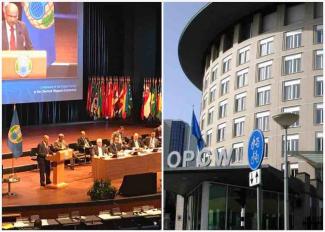Securing Our World: Countering Chemical Terrorism in the Age of New Technologies
On November 27, 2023, the Twenty-Eighth Session of the Conference of the States Parties to the Chemical Weapons Convention (CSP-28) opened in The Hague, Netherlands. This five-day meeting discusses various aspects associated with implementing the Chemical Weapons Convention (CWC), which has been in effect since April 29 1997. Organisation for the Prohibition of Chemical Weapons (OPCW) is responsible for fulfilling the Convention’s mandate.
The OPCW Director-General, while opening the CSP-28, mentioned that “Current developments in peace and security heighten the threat of chemical weapons use. In these challenging times, the Conference, as the highest decision-making body of the organisation, is required to take decisions and actions to preserve the norm against chemical weapons”. The key discussion topics for this Conference include actions required to be taken towards preventing chemical weapons re-emergence, addressing the threat from chemical weapons use and identifying science and technology developments relevant to the Convention’s implementation. The biggest success achieved by this Convention during 2023 is that now all chemical weapons stockpiles declared by the 193 States Parties to the CWC since 1997 — totalling 72,304 metric tonnes of chemical agents — have been irreversibly destroyed under the OPCW’s strict verification regime. The OPCW has worked tirelessly for the last 26 years to achieve this success.
The United States (US) was the biggest possessor of the chemical weapons stockpile when it joined the Convention some 25 years back. It had around 30,000 tons of chemical warfare agents at the time of the CWC ratification. It was a time-consuming, complicated, and costly task, and the destruction process was completed by July 7, 2023.
In accordance with the CWC mechanisms, eight states had declared possessing chemical weapons. These states include Albania, South Korea, India, Iraq, Syria, Libya, Russia and the US. Now, all these states have completed the destruction of their declared arsenals. However, it is important to note that just because the task of the total destruction of the chemical weapon stockpiles has been over does not mean that the world is free from the threat of chemical weapons. The threat of non-state actors using chemical weapons exists. Also, there is the possibility that some states could have joined the CWC as a non-possessor state but actually could be covertly holding some chemical weapons. States like Egypt, Israel, North Korea and South Sudan have not signed the CWC; hence, there always would be a needle suspicion.
The OPCW understands that issues like chemical terrorism should not be taken casually. There is an open-ended working group looking at such possibilities. In his address on November 27 2023, the OPCW Director-General mentioned that three meetings of this group have taken place, and they have also undertaken a table-top exercise. Today, the possible threat of chemical terrorism needs more attention for various reasons. Apart from the strategic faultiness, the leapfrog in the technology domain is a significant cause of concern. Robotics, Artificial Intelligence (AI), 3D Printing and some such technologies could be easily used by non-state actors to enhance their capabilities to undertake chemical attacks.
Robotics, mainly the use of drones, could pose a major threat in the near future. What non-state or an actor supported covertly by the state could use drones as a dispersal device to contaminate a larger area with chemical agents? Under the CWC, the definition of a chemical weapon includes all toxic chemicals and their precursors. But, for any terrorist organisation, such definitional boundaries do not apply, and they may use any available (or obtainable) chemical agent. What is readily available today is the delivery mechanism for creating chemical terror. Some decades back, chemical terror was a bit difficult (not impossible) proposal since there was always a chance of the terror group getting caught with a bulk load of chemical agents while manually spreading on target. Today, they can easily use commercial agricultural drones for this purpose. Such robotic equipment can be used to spray life-threatening chemicals the way drones are used for spraying pesticides. Purchases of such equipment do not require any special license, and the cost could be as low as US$ 1000. Alternatively, a terrorist could even use drones to prepare for attacks on chemical facilities.
The overall growth in information technology could be misused to create new and deadlier chemical weapons. It is possible to use computer designs to develop potential chemical weapons. Some pharmaceutical firms have conducted simulations to identify such possibilities. It has been found that AI-supported tools could help develop designs for 40,000 highly toxic molecules similar to and including the deadly nerve agent VX. This entire process took only around six hours.
3D Printing is another technology which could be effectively used for chemical terrorism. Terrorists can manufacture various types of delivery mechanisms like, say, drones for undertaking chemical terror attacks. Also, some reports indicate that the materials used for 3D Printing, such as ABS, PLA, and nylon, can be a source of dangerous Volatile Organic Compounds (VOCs) such as styrene, butanol, cyclohexanone, ethylbenzene, and others. In particular, heating ABS at a temperature typical for 3D printing results in high VOC emissions.
Overall, the ongoing CSP-28 needs to address the issues related to terrorism and new technologies in a much-focussed manner. The new technologies have the potential to be used for malicious purposes. As such, there is a fear that ‘Algorithms’ will dictate the future of the human race. OPCW needs to ensure that ‘Algorithms’ and human or ‘Autonomous’ controlled vehicles are not getting misused for spreading chemical terror.
Selected Sources:
- “3D Printing Hazards”, DuraLabel, February 03, 2023
- OPCW, “28th Session of the Conference of the States Parties” November 27-December 01, 2023.
- Zachary Kallenborn, “Why cheap drones pose a significant chemical terrorism threat”, Bulletin of the Atomic Scientists, November 21, 2023.
